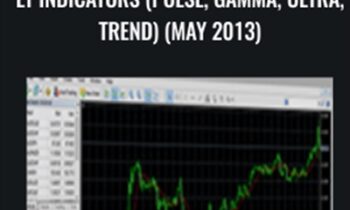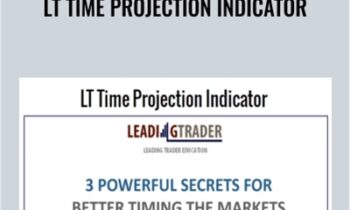
Available only $72, Mean Reversion Strategies In Python – Dr. Ernest P. Chan-Quantinsti Course
Author: Dr. Ernest P. Chan-Quantinsti
Course name: Mean Reversion Strategies In Python
Langugues: English
Included:
Total size: 216 MB
Original price was: $212.00.$72.00Current price is: $72.00.
Unlock your potential with the Available only $72, Mean Reversion Strategies In Python – Dr. Ernest P. Chan-Quantinsti Course course for only Original price was: $212.00.$72.00Current price is: $72.00. at WSOLib.com! Discover our vast library of over 60,000 downloadable digital courses across Forex and Trading. Get expert-guided, self-paced learning and save over 80% compared to retail prices. Transform your skills today!
You will receive after purchasing
- The course link always exists, download whenever you need.
- Study anywhere on any device.
- Your identity is completely confidential. 100% Safe Checkout Privateness coverage.
- The course quality is similar to the sales page. Save more …
- Purchase Mean Reversion Strategies In Python course only $72
- Find out more about the course’s content from the Salespage. Click HERE.
- We only offer courses with downloadable digital content.
- Do not provide relevant Dr. Ernest P. Chan-Quantinsti Author access.
Offered by Dr. Ernest P Chan, this course will teach you to identify trading opportunities based on Mean Reversion theory. You will create different mean reversion strategies such as Index Arbitrage, Long-short portfolio using market data and advanced statistical concepts. A must-do course for quant traders.
APPLY MEAN REVERSION STRATEGIES
Create four different types of mean reverting strategies
Perform statistical test for identifying stationarity and co-integration
Backtest pairs trading, triplets, index arbitrage and long-short strategy
Explain the role of risk management
Paper trade and live trade your strategies without any installations or downloads
Introduction to the Course
This section gives an overview of the mean reversion strategy through examples. You will go through the course structure and understand how the course is structured in videos, quizzes, strategy codes and interactive coding exercises. This will make sure that not only do you understand the mechanics of mean reversion but also implement trading strategies in live markets.
Introduction by Dr. Ernest Chan
Introduction to Mean Reversion Strategy
Course Structure Flow Diagram
Quantra Features and Guidance
Types of Statistical Arbitrage Strategies
Stationarity of Time Series
Stationary is one of the essential concepts upon which pairs trading and other cointegrated trading is built. This section discusses the concept of stationary through real price data and how it is different from the random walk.
What is Stationarity?
Mean Reversion Trading Approach
Temporary Mean Reversion
Stationarity
Statistical Test for Stationarity
Augmented Dickey-Fuller Test
This section covers the concept of the augmented dickey-fuller (ADF) test, which is used to check whether the price series is stationary or not. You will learn the mathematics behind the ADF test. You will also learn to check the stationarity of currency pairs in Python.
Pre Reading Materials
What is ADF Test?
Purpose of ADF Test
ADF Test Assumption
Null Hypothesis
Stationary Price Series
Math Behind ADF Test (Optional)
Critical Value and Test Statistics
How to Use Jupyter Notebook?
ADF Test on CADUSD Pair
Calculate Test Statistics
Import Library and Read CSV
Additional Reading
Frequently Asked Questions
Mean Reversion Strategy
In this section, you will learn to create and backtest a trading strategy based on the concept of mean reversion. You will learn to use the Bollinger Bands to create a mean reversion strategy on a currency pair.
Mean Reversion Strategy
Upper Band
Trading Based on Mean Reversion
Mean Reversion Strategy on AUDCAD
Calculate Moving Average and Standard Deviation
Upper and Lower Band
Long Entry and Exit
Short Entry and Exit
Long and Short Positions
Forward Fill Missing Positions
Consolidate the Positions
Compute PnL
Recap
Frequently Asked Questions
Test on Mean Reversion
Live Trading on Blueshift
This section will walk you through the steps involved in taking your trading strategy live. You will learn about backtesting and live trading platform, Blueshift. You will learn about code structure, various functions used to create a strategy and finally, paper or live trade on Blueshift.
Section Overview
Live Trading Overview
Vectorised vs Event Driven
Process in Live Trading
Real-Time Data Source
Blueshift Code Structure
Important API Methods
Schedule Strategy Logic
Fetch Historical Data
Place Orders
Backtest and Live Trade on Blueshift
Additional Reading
Blueshift Data FAQs
Live Trading Template
In this section, a live trading strategy template will be provided to you. The template strategy will be on the mean reversion strategy covered in the previous section. You can tweak the code by changing different currency pairs, date range to backtest and finally analyse the strategy performance in more detail.
Paper/Live Trading FX Mean Reversion Strategy
FAQs for Live Trading on Blueshift
Cointegration
Free Preview
If a linear combination of two or more price series is stationary, then the individual price series are said to be cointegrated with each other. This section introduces cointegration between two-time series and covers a test for detecting cointegration of a portfolio of instruments called the cointegrated augmented Dickey-Fuller (CADF) test.
What is Cointegration?
Cointegration
Correlation
What is Hedge Ratio?
Portfolio Formation Using Hedge Ratio
Hedge Ratio Code
Import Library
Calculate Hedge Ratio
What is CADF Test?
Check Cointegration using CADF Test
Order Dependence of CADF
Pairs Trading
Most financial instruments are not stationary, and creating a mean reversion strategy is not possible on such a price series. To overcome this issue, you need two price series which are cointegrated with each other. In this section, you will learn to create a pairs trading strategy using the Bollinger Bands. You will also learn to backtest the same in Python.
Mean Reversion Strategy on Pairs
Mean Reversion Strategy on GLD-GDX
Take Long Entry and Exit
Compute Strategy PnL
Paper/Live Trading Pair Trading Strategy
Additional Reading
Recap
Mean Reversion Strategy
Triplets
This section discusses failure of the mean reversion strategy of the GLD-GDX pair. Based on the possible reason we will arrive at the conclusion of choosing a triplet to improve the mean reversion strategy. The working of Johansen test will be explained to arrive at the hedge ratios for the new mean reversion strategy for triplets. This section also covers the concept of half-life of mean reversion along with Ornstein-Uhlenbeck formula for computing the half-life of mean reversion.
Cointegration Breakdown in the GLD-GDX Pair
Reason of Breakdown of Cointegration
Significance of Cointegration
Surviving Breakdown of Cointegration
How to Survive Breakdown of Cointegration?
Breakdown Remedies
Optimization Problems
Eigenvalues and Eigenvectors
What is Johansen Test?
CADF Shortcomings
Linear Combination
GLD-GDX Cointegration Test
Mean Reversion on Triplets
Mean Reversion on Triplets Code
GLD-GDX-USO Cointegration Test
Cointegration Test
Taking Positions
Recap
Frequently Asked Questions
Half Life
This section explains how long would it it take for the time series to revert back to the mean. And the importance of half-life to select the right instruments to trade in.
Half Life of Mean Reverting Time Series
Half Life
Half Life Formula
Half-Life Using Johansen Test
Compute Half-Life of GLD-GDX
Frequently Asked Questions
Risk Management
This section explains the importance and two common usages of stop loss in mean reverting strategies. Further, you will learn to backtest mean-reverting strategy with and without stop and compare the performance of the strategy.
Stop-Loss
Mean Reversion Strategy With Stop Loss
Best Markets to Pair Trade
This section explains the pros and cons of mean reversion strategies in different markets such as exchange traded funds (ETFs), stocks, currencies, and futures. Further, in the section, will understand how economically related pairs do not co-integrate, cover the basic concept of crack spread and test for stationarity of crack spread.
Best Markets To Pair Trade
Mean Reversion of ETF Pairs
Mean Reversion of Stock Pairs
Mean Reversion of Currencies and Futures
Cointegration Test of CL and BZ
Cointegration Test of Crack Spread
Identify Cointegrated Stock Pairs
Index Arbitrage
This section explains Index Arbitrage Strategy which is an extension of pairs and triplets, how to construct a basket of instruments and see the difficulties of trading an Index Arbitrage strategy.
Index Arbitrage Strategy
Working of Index Arbitrage Strategy
Custom Basket
Index Arbitrage Strategy Code
Difficulties in Index Arbitrage
Long Short Portfolio
This section explains the concept of long-short portfolio strategy, how it is different from other mean reversion strategies. Further, will construct a long-short portfolio of stocks in the S&P 500, understand the importance of universe selection of stocks on strategy and learn to refine a strategy.
Long-Short portfolio Strategy
Long-Short Portfolio
Strategy Formula
Long-Short Portfolio Strategy Code
Calculate Stock Returns
Calculate Market Returns
Calculate Dollar Allocation for Each Stock
Calculate Sharpe Ratio
Paper/Live Trading Long-Short Strategy
Analysis of Strategy Performance
Test on Trading Based on Mean Reversion
Run Codes Locally on Your Machine
Learn to install the Python environment in your local machine.
Python Installation Overview
Flow Diagram
Install Anaconda on Windows
Install Anaconda on Mac
Know your Current Environment
Troubleshooting Anaconda Installation Problems
Creating a Python Environment
Changing Environments
Quantra Environment
Troubleshooting Tips For Setting Up Environment
How to Run Files in Downloadable Section?
Troubleshooting For Running Files in Downloadable Section
Automated Trading Using IBridgePy
A live trading strategy template will be provided to you. You can tweak the template to deploy your strategies on Interactive Brokers using IBridgePy API.
Additional Reading
Sample Strategy to Run on Interactive Brokers
Summary
Course Summary
Python Codes and Data
Tag: Mean Reversion Strategies In Python – Dr. Ernest P. Chan-Quantinsti Download, Mean Reversion Strategies In Python – Dr. Ernest P. Chan-Quantinsti review, Mean Reversion Strategies In Python – Dr. Ernest P. Chan-Quantinsti Discount, mean reversion strategies, short term mean reversion strategies, mean reversion strategies trading, best mean reversion strategies, mean reversion strategies in python
Secure your future with the Available only $72, Mean Reversion Strategies In Python – Dr. Ernest P. Chan-Quantinsti Course course at WSOLib.com! Gain lifetime access to expertly curated content, empowering your career and personal development.
- Lifetime Access: Enjoy unlimited access to your digital courses.
- Huge Savings: Prices are consistently up to 80% lower than original sales pages.
- Secure Transactions: Shop with confidence using our trusted payment methods.
- Actionable Knowledge: Acquire real-world skills from diverse topics.
- Instant Delivery: Start learning immediately after purchase.
- Device Flexibility: Access your courses on desktop, mobile, or tablet.
Begin your learning journey with WSOLib.com!
Specification: Available only $72, Mean Reversion Strategies In Python – Dr. Ernest P. Chan-Quantinsti Course
|
User Reviews
Only logged in customers who have purchased this product may leave a review.




There are no reviews yet.